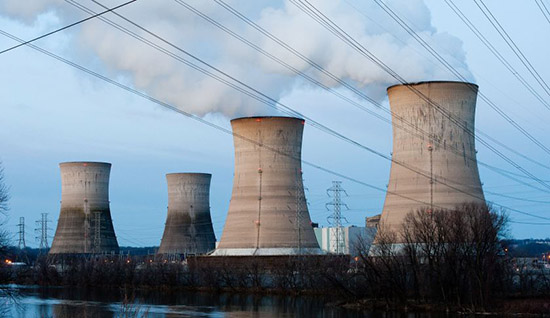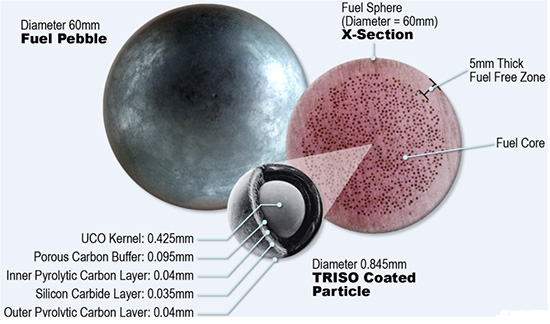這家初創(chuàng)公司要設(shè)計更安全、更小的核反應堆

|
幾年前,參與創(chuàng)建空間承包公司SGT的伊朗裔美國人、連續(xù)創(chuàng)業(yè)者甘·加法瑞恩前往法國南部進行了一次精神修行。這次靈魂之旅讓他對核能技術(shù)產(chǎn)生了興趣。 加法瑞恩并非是唯一的一位突然對新型核能感興趣的成功商人。微軟聯(lián)合創(chuàng)始人比爾·蓋茨在一家名為TerraPower的核能初創(chuàng)公司投資了數(shù)百萬美元,亞馬遜CEO杰夫·貝佐斯也投資了核聚變初創(chuàng)公司General Fusion。微軟另外一位聯(lián)合創(chuàng)始人保羅·艾倫則看好核聚變初創(chuàng)公司Tri Alpha Energy。 相比開發(fā)手機應用、聯(lián)網(wǎng)設(shè)備或數(shù)據(jù)算法的公司,核能初創(chuàng)公司相對稀少。但現(xiàn)在,數(shù)十家核能初創(chuàng)公司有望成就核能領(lǐng)域里的下一個大事件。這些公司成敗的關(guān)鍵,是將一種人類急需的能源商業(yè)化,這種能源既不會造成氣候變化,還可以幫助復興苦苦掙扎的核能行業(yè)。 這趟法國自省之旅,促使加法瑞恩創(chuàng)建了一家名為X-energy的核能初創(chuàng)公司。如果你沒聽說過這家公司,那也是情有可原的。這家公司自2009年起開始低調(diào)運營,致力于采用德國幾十年前開發(fā)的技術(shù),設(shè)計更安全、更小巧的核反應堆。 上個月,這家公司才引起關(guān)注,因為它獲得了美國能源部提供的4000萬美元撥款,用于建造先進的核電反應堆。這筆撥款足以改變行業(yè)態(tài)勢。僅有兩家公司獲得了政府的財政資助,X-energy便是其中之一。這家公司在十多家競爭對手中脫穎而出,其中包括多家規(guī)模達數(shù)十億美元的成熟公司。 當然,公司并不能直接得到全部資金,而是可以在實現(xiàn)里程碑事件時得到撥款。此外,撥款還有成本分攤要求,已在X-energy投入2000萬美元的加法瑞恩,已經(jīng)同意追加投資數(shù)百萬美元。 X-energy計劃利用這筆資金,將員工隊伍擴大一倍,增加到約30人,并繼續(xù)開發(fā)其核反應堆設(shè)計和燃料生成工藝。借助這筆撥款,X-energy還將與科技領(lǐng)域的多個合作伙伴合作,包括俄勒岡州立大學、愛達荷國家實驗室和橡樹嶺國家實驗室。 對于加法瑞恩和科技領(lǐng)域的億萬富翁們來說,對核能技術(shù)的興趣,很大程度上源于通過開發(fā)技術(shù)產(chǎn)生重要的影響,解決足以改變世界的難題。雖然能源行業(yè)規(guī)模龐大,但投資新型核能技術(shù),絕非快速輕松的賺錢途徑。 加法瑞恩對《財富》雜志表示,他對核能技術(shù)的興趣“帶有慈善性質(zhì)”,是為了“回饋社會”。事實上,新型核反應堆上市動輒需要數(shù)十億美元的投入,因此美國能源部的撥款可謂杯水車薪。但加法瑞恩和X-energy總裁哈倫·鮑爾斯希望美國能源部的撥款,能夠吸引新投資者和合作伙伴的興趣。 X-energy正在研究一種新型核反應堆——球床模塊式反應堆。其中的“球”是指網(wǎng)球大小的石墨球,內(nèi)有帶陶瓷涂層的微型鈾芯塊。這家公司的反應堆內(nèi)堆積了約17萬個這種石墨球,足以進行核子反應,產(chǎn)生熱能。 |
When serial entrepreneur Kam Ghaffarian, an Iranian-American who co-founded space contractorSGT, went on a spiritual retreat years ago in the South of France, his soul searching kicked off a new found fascination with nuclear technology. Ghaffarian isn’t the only successful businessman to suddenly become intrigued by new forms of nuclear energy. Microsoft co-founder Bill Gates plowed millions into a nuclear startup called TerraPower, while Amazon’s CEO Jeff Bezos funded nuclear fusion startup General Fusion. Microsoft’s other co-founder Paul Allen became smitten with another nuclear fusion startup called Tri Alpha Energy. While nuclear startups are quite rare compared to those that make mobile apps, connected devices, or data algorithms, dozens of ambitious nuclear startups are now vying to be the next big thing in nuclear energy. At stake is a chance to commercialize a much needed energy source that doesn’t contribute to climate change and which could help revive a struggling nuclear industry. The result of Ghaffarian’s French introspection is a nuclear startup called X-energy, and you’re forgiven if you’ve never heard of it. The company has been operating under the radar since 2009, and working on designs for a safer and smaller nuclear reactor that uses a technology first developed in Germany decades ago. The company was outed last month by what could be a game-changing $40 million grant from the Department of Energy to build its advanced nuclear energy reactor. X-energy was one of only two companies to receive the government financing, and the firm competed against over a dozen companies, many well-established billion-dollar corporations. The company doesn’t receive all of the funds outright, but will have access to the money as, or if, milestones are met. The grant also requires cost-sharing, and Ghaffarian, who has already invested $20 million of his own money into X-energy, has agreed to provide millions of dollars more. X-energy plans to spend the funds on doubling its staff to about 30 people, and continuing development of its reactor designs and fuel creation process. Through the grant, X-energy will also work with a handful of partners on the tech, including Oregon State University, Idaho National Laboratory, and Oak Ridge National Laboratory. For Ghaffarian—and for the tech billionaires, too—the intrigue into nuclear energy tech is largely about advancing technology that can have a big impact on a difficult, world-changing, problem. Despite that the energy markets are vast industries, investing in new nuclear technology is by no means a fast and easy way to make money. Ghaffarian tells Fortune that his interest in the nuclear tech is “philanthropic” and is “about giving back.” Indeed, the DOE grant is a drop in the bucket when it comes to the roughly billion dollars needed to get a new type of nuclear reactor to market. But Ghaffarian, and X-energy’s President Harlan Bowers, are hopeful the DOE recognition will also lead to interest from new investors and new partners. X-energy is working on a type of nuclear reactor called a pebble bed modular reactor. The pebbles are in reference to tennis-ball-sized spheres of graphite, which house tiny pellets of uranium that are coated in ceramic. Inside the company’s reactor they’ll pile up about 170,000 of these pebbles, which is enough to start a nuclear reaction, and generate heat. |

|
我們目前熟知的傳統(tǒng)大型核反應堆,多數(shù)用水來冷卻鈾棒。燃料棒需要通過持續(xù)的水流來保持冷卻。若因任何原因?qū)е滤至魇В磻褧霈F(xiàn)過熱和融化。后果將不堪設(shè)想。 日本福島核災難的原因,便是一次大規(guī)模地震導致三個反應堆的水冷系統(tǒng)關(guān)閉。雖然電力公司最終開始向過熱的反應堆注入海水,但為時已晚,反應堆已經(jīng)釋放出了放射性物質(zhì)。 而X-energy的球床反應堆并不采用水冷,而是通過使氦氣流經(jīng)石墨球來控制溫度。除了冷卻劑不同外,X-energy公司的鮑爾斯表示,他們所采用的鈾(鈾235)會在特定溫度閾值時開始冷卻,基本上可以實現(xiàn)自我調(diào)節(jié)。 X-energy正在設(shè)計的反應堆,規(guī)模較小,低于普通的千兆瓦級核電廠。每一座Xe-100反應堆可發(fā)電50兆瓦特,或125兆瓦特熱量,只是一座千兆瓦級核反應堆發(fā)電量的一小部分。但多座Xe-100反應堆可以組裝在一起,形成更大的核動力發(fā)電機。 由于這種技術(shù)采用模塊化設(shè)計,比傳統(tǒng)核電更安全,因此按照加法瑞恩和鮑爾斯的設(shè)想,這種技術(shù)不僅可用于電網(wǎng)公司,希望不受電網(wǎng)約束發(fā)熱和發(fā)電的公司也可以采用這項技術(shù)。加法瑞恩希望將這種技術(shù)部署在電網(wǎng)鏈接前景渺茫的發(fā)展中國家。 你或許會疑問,既然球床反應堆技術(shù)如此優(yōu)秀,這么多年來的努力為什么一直沒有取得成果?事實上,多年來,德國、南非、美國和中國的多家機構(gòu)一直在嘗試并且建成了這種類型的反應堆,但科學家們一直無法以經(jīng)濟上可行的方式實現(xiàn)商業(yè)化,或保證沒有技術(shù)問題。 當然,X-energy的雄心依舊。目前,公司尚處在概念設(shè)計階段,完成設(shè)計需要更長時間。 在未來7到9年內(nèi),如果獲得所需的資金,該公司向核能管理委員會申請反應堆建造許可。X-energy計劃在20年內(nèi)或到2035年,開始運營一座用來展示的反應堆。 漫長的時間和巨大的資金需求,是導致核能初創(chuàng)公司較少的主要原因之一。要想做好一個需要20年時間才能實現(xiàn)商業(yè)化的項目,創(chuàng)業(yè)者需要有足夠的勇氣和堅定的信念。(財富中文網(wǎng)) 譯者:劉進龍/汪皓 審校:任文科 |
Most of those older giant nuclear reactors you hear about use water to cool uranium rods. The fuel rods need a constant flow of water across them to keep them cool. If the water is removed for whatever reason, the reactor can overheat and meltdown. And that’s really bad. The Fukushima nuclear disaster was caused when a massive earthquake shut down the water cooling system at three reactors in Japan. The utility eventually started pouring sea water onto the overheating reactors but by then it was too late and radioactive materials had been released. Instead of using water, X-energy’s pebble bed reactor will flow helium across the pebbles to keep the temperature down. But in addition to a different coolant, X-energy’s Bowers says the form of uranium they will use (Uranium 235) starts to cool down at a certain temperature threshold, so it can essentially self-regulate itself. Currently X-energy is designing its reactors at a much smaller scale than the typical gigawatt-scale nuclear plant. Each X-energy reactor, called the Xe-100, will generate 50 megawatts of electricity, or 125 megawatts of heat, just a fraction of what a gigawatt nuclear reactor would produce. But multiple Xe-100’s could be strung together to make much larger nuclear generators. Because the tech is modular and safer than traditional nuclear, Ghaffarian and Bowers envision that it could be used by not just utilities for the power grid, but also companies that want to generate heat and electricity independent of the grid. Ghaffarian hopes that the tech could be deployed in the developing world where power grid access is a distant dream. You’re probably wondering if the pebble bed tech is so great, why haven’t former efforts over the years come to fruition? Many groups in Germany, South Africa, the U.S. and China have tried over the years, and indeed built reactors, but scientists haven’t been able to commercialize the technology economically or without technical issues. Of course all of X-energy’s ambitions are still just that. The company is only at the conceptual design phase, and will need many more years to complete its designs. If the company gets its funding, in maybe seven to nine years, it plans to engage with the Nuclear Regulatory Commission, which doles out licenses to build reactors. X-energy plans to start operating a demonstration reactor within the next twenty years, or by 2035. The long timelines and huge funding challenges are one of the main reasons there aren’t more nuclear startups out there. It takes a brave, and stubborn, entrepreneur to tackle a project that will take 20 years to commercialize. |













